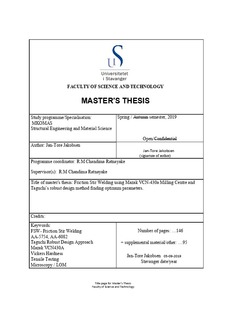| dc.contributor.advisor | Chandima, Ratnayka R.M. | |
| dc.contributor.author | Jakobsen, Jan-Tore | |
| dc.date.accessioned | 2020-01-15T09:04:24Z | |
| dc.date.available | 2020-01-15T09:04:24Z | |
| dc.date.issued | 2019-09-05 | |
| dc.identifier.uri | http://hdl.handle.net/11250/2636333 | |
| dc.description | Master's thesis in Stuctural Engineering | nb_NO |
| dc.description.abstract | Friction Stir welding has become an important method for welding of aluminium alloys. Excellent mechanical properties, economic benefits and environment friendly is just some of the advantages compared to ordinary fusion welding. However, large investments are needed as the workpiece need to be clamped properly against the worktable to resist any movement and the machine have to produce a large downforce. FSW can be performed using ordinary CNC- machines but force control or position control are suggested to make sound welds. This experiment used a Mazak VCN430a vertical milling centre and tools from Stirweld. The welding was conducted without any force control or force measuring system. To get a better control of the shoulder depth, the plates surface was measured using a measuring probe and the surface curvature was interpolated along the weld path. Friction stir welding was successfully performed on 300x150x3 mm plates of AA6082-T6 alloy using the Tagushi robust design approach. Optimal parameters for this particular machine and experiment was found to be 1200 rpm for the rotation speed, 150 mm/min for the welding speed, 2 seconds dwell time and a shoulder depth of 0.11 mm. The matrix experiment revealed almost the same value for the 0.07 mm shoulder depth which can be a prove of interaction among the parameters. Ultimate tensile strength test for the optimal weld parameters was 222.7 MPa. The predicted value was higher, but the measured value was inside the 2-standard confidence interval. Vickers hardness test showed that weakening of material had occurred throughout the specimen. The measured value 60 mm from the weld centre was approximately 75 Vickers HV. Developing the welding jig, clamping system and also simultaneously finding welding parameters without having any force control or position control proved itself to be very difficult. The clamping system seemed to be the most important factor to be able producing sound welds. For further friction welding experiment a welding jig and clamping system with the possibility of force control or position control need to be considered to eliminate defects. | nb_NO |
| dc.language.iso | eng | nb_NO |
| dc.publisher | University of Stavanger, Norway | nb_NO |
| dc.relation.ispartofseries | Masteroppgave/UIS-TN-IMBM/2019; | |
| dc.rights | Navngivelse 4.0 Internasjonal | * |
| dc.rights.uri | http://creativecommons.org/licenses/by/4.0/deed.no | * |
| dc.subject | FSW- Friction Stir Welding | nb_NO |
| dc.subject | AA-5754, AA-6082 | nb_NO |
| dc.subject | Taguchi Robust Design Approach | nb_NO |
| dc.subject | Mazak VCN430A | nb_NO |
| dc.subject | Vickers Hardness | nb_NO |
| dc.subject | tensile testing | nb_NO |
| dc.subject | microscopy / LOM | nb_NO |
| dc.subject | materialteknologi | nb_NO |
| dc.title | Friction Stir Welding using Mazak VCN-430a Milling Centre and Taguchi’s robust design method finding optimum parameters. | nb_NO |
| dc.type | Master thesis | nb_NO |
| dc.subject.nsi | VDP::Technology: 500::Building technology: 530::Construction technology: 533 | nb_NO |

